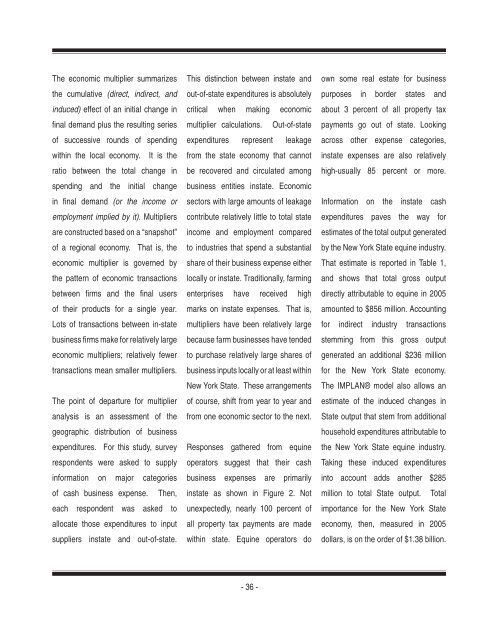Retired Racehorses
tfrr_reportandappendicesfinal
tfrr_reportandappendicesfinal
- No tags were found...
You also want an ePaper? Increase the reach of your titles
YUMPU automatically turns print PDFs into web optimized ePapers that Google loves.
The economic multiplier summarizes<br />
the cumulative (direct, indirect, and<br />
induced) effect of an initial change in<br />
final demand plus the resulting series<br />
of successive rounds of spending<br />
within the local economy. It is the<br />
ratio between the total change in<br />
spending and the initial change<br />
in final demand (or the income or<br />
employment implied by it). Multipliers<br />
are constructed based on a “snapshot”<br />
of a regional economy. That is, the<br />
economic multiplier is governed by<br />
the pattern of economic transactions<br />
between firms and the final users<br />
of their products for a single year.<br />
Lots of transactions between in-state<br />
business firms make for relatively large<br />
economic multipliers; relatively fewer<br />
transactions mean smaller multipliers.<br />
The point of departure for multiplier<br />
analysis is an assessment of the<br />
geographic distribution of business<br />
expenditures. For this study, survey<br />
respondents were asked to supply<br />
information on major categories<br />
of cash business expense. Then,<br />
each respondent was asked to<br />
allocate those expenditures to input<br />
suppliers instate and out-of-state.<br />
This distinction between instate and<br />
out-of-state expenditures is absolutely<br />
critical when making economic<br />
multiplier calculations. Out-of-state<br />
expenditures represent leakage<br />
from the state economy that cannot<br />
be recovered and circulated among<br />
business entities instate. Economic<br />
sectors with large amounts of leakage<br />
contribute relatively little to total state<br />
income and employment compared<br />
to industries that spend a substantial<br />
share of their business expense either<br />
locally or instate. Traditionally, farming<br />
enterprises have received high<br />
marks on instate expenses. That is,<br />
multipliers have been relatively large<br />
because farm businesses have tended<br />
to purchase relatively large shares of<br />
business inputs locally or at least within<br />
New York State. These arrangements<br />
of course, shift from year to year and<br />
from one economic sector to the next.<br />
Responses gathered from equine<br />
operators suggest that their cash<br />
business expenses are primarily<br />
instate as shown in Figure 2. Not<br />
unexpectedly, nearly 100 percent of<br />
all property tax payments are made<br />
within state. Equine operators do<br />
own some real estate for business<br />
purposes in border states and<br />
about 3 percent of all property tax<br />
payments go out of state. Looking<br />
across other expense categories,<br />
instate expenses are also relatively<br />
high-usually 85 percent or more.<br />
Information on the instate cash<br />
expenditures paves the way for<br />
estimates of the total output generated<br />
by the New York State equine industry.<br />
That estimate is reported in Table 1,<br />
and shows that total gross output<br />
directly attributable to equine in 2005<br />
amounted to $856 million. Accounting<br />
for indirect industry transactions<br />
stemming from this gross output<br />
generated an additional $236 million<br />
for the New York State economy.<br />
The IMPLAN® model also allows an<br />
estimate of the induced changes in<br />
State output that stem from additional<br />
household expenditures attributable to<br />
the New York State equine industry.<br />
Taking these induced expenditures<br />
into account adds another $285<br />
million to total State output. Total<br />
importance for the New York State<br />
economy, then, measured in 2005<br />
dollars, is on the order of $1.38 billion.<br />
- 36 -


